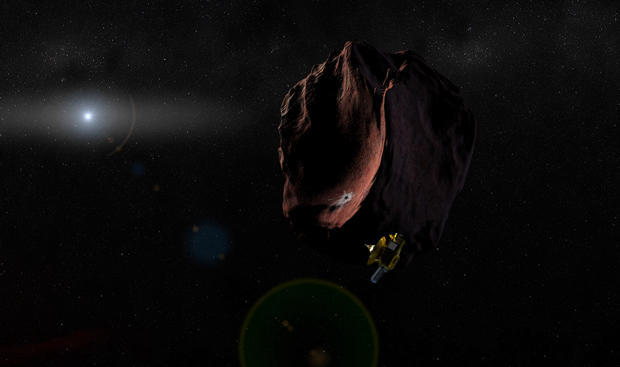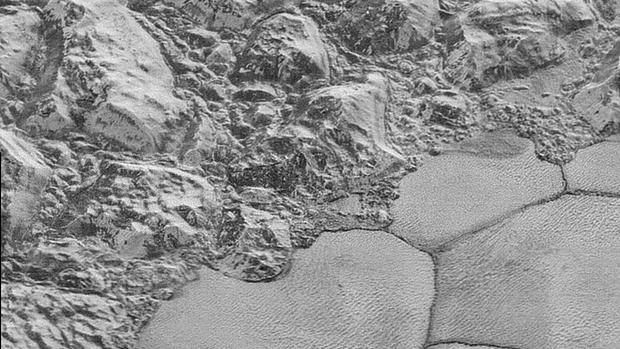Streaking through space at nearly nine miles per second, NASA's New Horizons probe closed in on a frozen remnant of the solar system's birth Monday, on track for a historic New Year's Day flyby of the most distant body ever explored.
Officially known as 2014 MU69, the target is a small, 19-mile-wide object in the remote Kuiper Belt a billion miles past Pluto, a body so far away -- 4.1 billion miles from Earth -- it appears as little more than a speck of light even to the Hubble Space Telescope.
Dubbed "Ultima Thule" (pronounced TOO-lee) in a NASA naming contest, the small body is thought to be literally frozen in time, a pristine remnant of the original disk of rocky debris that coalesced to form the solar system some 4.6 billion years ago.
New Horizons will fly within 2,200 miles of Ultima Thule during the New Year's Day encounter, mapping its surface with a suite of cameras, spectrometers and other instruments to probe its structure and chemical makeup, giving scientists a close-up look at one of the solar system's original building blocks.
Close approach, at a velocity of some 32,000 mph -- 12 times faster than a high-velocity rifle bullet -- is targeted for 12:33 a.m. EST (GMT-5) Tuesday. The spacecraft will be out of contact during the encounter, but it is programmed to phone home later Tuesday morning with an engineering status report.
It will take those radio signals six hours and eight minutes to cross the 4.1 billion miles to Earth, arriving at 10:29 a.m. The first science data and high-priority images will begin making their way back to the inner solar system later in the day. The first high-resolution image is expected to be unveiled during a news briefing Wednesday.
"This is a very mysterious object," said Hal Weaver, the New Horizons project scientist. "This is potentially the most primitive object that's ever been visited by a spacecraft. ... We think it was one of the earliest objects that formed, and who the heck knows what it's going to look like, what it's going to tell us?"
Engineers and scientists at Johns Hopkins University's Applied Physics Laboratory near Baltimore checked the spacecraft's trajectory Sunday and uplinked commands to make a two-second adjustment to the probe's science timeline.
Alice Bowman, the New Horizons mission operations manager at APL, said the latest navigation data showed the spacecraft would pass within 19 miles of its 2,200-mile close-approach aim point, a virtual bullseye given the billion miles it's traveled since streaking past Pluto in 2015.
"This last day has probably been the most intense for us," she said. "We had these optical navigation measurements coming down much closer together, that means a lot of the team was up all night."
She said some team members brought sleeping bags, and one set up a tent in his office. "We're happy to spend the night if that's what it takes," she said.
Precise navigation before the encounter is critical because the spacecraft will be totally on its own as it executes a complex sequence of observations and maneuvers, far beyond any help from anxious flight controllers at APL.
The round-trip "light time" from Earth to New Horizons and back is more than 12 hours, ruling out any realtime interactions. While engineers are confident everything will work as planned, the spacecraft has fault-protection software on board to recover from any problems that might crop up.
"Because this is a flyby mission, we only get one chance to get it right, we can't go back and do it again," Bowman said Friday. "So we have this special mode we put the spacecraft in and what that does is it protects all the science observations.
"So if we have any kind of abnormal condition on the spacecraft, the autonomy system will try to fix it as best it can and then it will pick up with the next measurement and we'll continue taking data."
The same strategy was used during New Horizons' successful flyby of Pluto, and flight controllers are optimistic the spacecraft will chalk up another success with Ultima Thule.
But for the science team, a large dose of patience will be required.
While the flyby will happen in the blink of an eye, it will take 20 months for the gigabytes of stored data to make their way back to Earth, thanks to the enormous distances involved and the probe's 30-watt radio transmitter, which operates at power levels comparable to a refrigerator light.
But mission managers have prioritized the transmission sequence to ensure a high-resolution image comes down in the first batch of data.
https://www.cbsnews.com/news/new-horizons-nasa-space-probe-closes-in-for-historic-new-years-day-flyby-ultima-thule/Bagikan Berita Ini
















0 Response to "New Horizons NASA space probe closes in for historic New Year's Day flyby of Ultima Thule in Kuiper Belt - CBS News"
Post a Comment